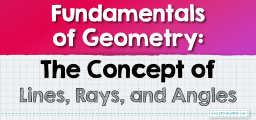Angles of Rotation

An angle of rotation is the measure of the angle formed by the initial and final positions of a point or object that has been rotated about a fixed point. The angle of rotation is typically measured in degrees or radians.
Related Topics
- Function Values of Special Angles
- How to Solve Angles and Angle Measure
- How to Apply Trigonometry to General Triangles
- How to Solve Coterminal Angles and Reference Angles
- How to Find Missing Sides and Angles of a Right Triangle
Step-by-step to angles of rotation
Here are some examples of how to use angles of rotation to solve problems:
1. Finding the degree measure of rotation: To find the degree measure of rotation, you can use the formula:
angle of rotation = final position – initial position
For example, if a point is rotated from a position of \(30\) degrees to a final position of \(90\) degrees, the angle of rotation would be \(90 – 30 = 60\) degrees.
2. Finding the final position: To find the final position of an object after a rotation, you can use the formula:
final position = initial position + angle of rotation
For example, if an object is rotated from an initial position of \(0\) degrees by an angle of rotation of \(45\) degrees, the final position would be \(0 + 45 = 45\) degrees.
3. Solving a word problem: To solve a word problem involving angles of rotation, you can use the formulas and concepts of angles of rotation to find missing information. For example, if a wheel completes \(3\) full rotations, the angle of rotation is \(360 * 3 = 1080\) degrees.
4. Rotations in the coordinate plane: You can use angles of rotation to find the coordinates of a point after it has been rotated about a fixed point in the coordinate plane. For example, if a point \((x, y)\) is rotated about the origin by an angle of rotation \(θ\), the new coordinates of the point \((x’, y’)\) can be found using the rotation matrix:
\(\begin{bmatrix}x’ \\y’ \end{bmatrix}\)\(=\)\(\begin{bmatrix}cosθ & -sinθ \\sinθ & cosθ \end{bmatrix}\)\(=\)\(\begin{bmatrix}x \\y \end{bmatrix}\)
It’s important to notice that positive angles of rotation are counterclockwise and negative angles are clockwise.
It’s also important to be aware of the conventions used when working with angles of rotation, such as whether angles are measured in degrees or radians.
Angles of rotation are widely used in various fields such as physics, engineering, computer graphics, and many more.
Related to This Article
More math articles
- 10 Most Common SHSAT Math Questions
- How to Divide Polynomials?
- How to Solve Perfect Square Trinomial?
- 4th Grade North Carolina End-of-Grade Math Worksheets: FREE & Printable
- The Ultimate ACCUPLACER Math Formula Cheat Sheet
- How to Find Units of Time Comparison
- How to Solve Absolute Values and Opposites of Rational Numbers?
- How Good Do You Need to Be at Math to Play Baccarat?
- Top 10 8th Grade OST Math Practice Questions
- 5th Grade Georgia Milestones Assessment System Math FREE Sample Practice Questions


























What people say about "Angles of Rotation - Effortless Math: We Help Students Learn to LOVE Mathematics"?
No one replied yet.